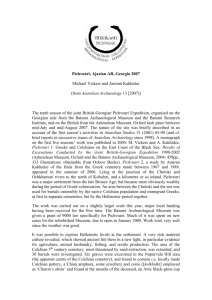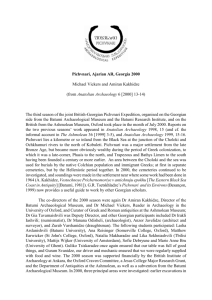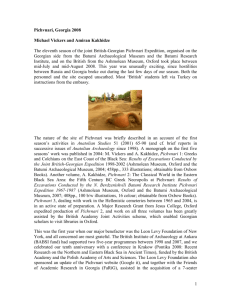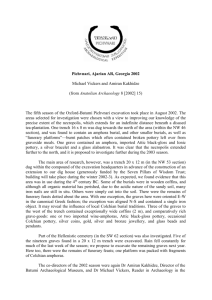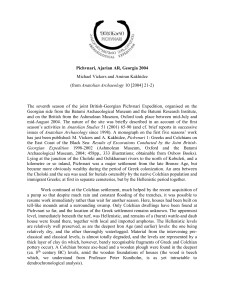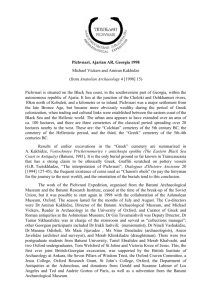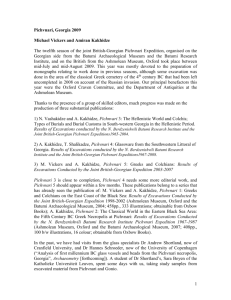doc - University of Oxford
advertisement
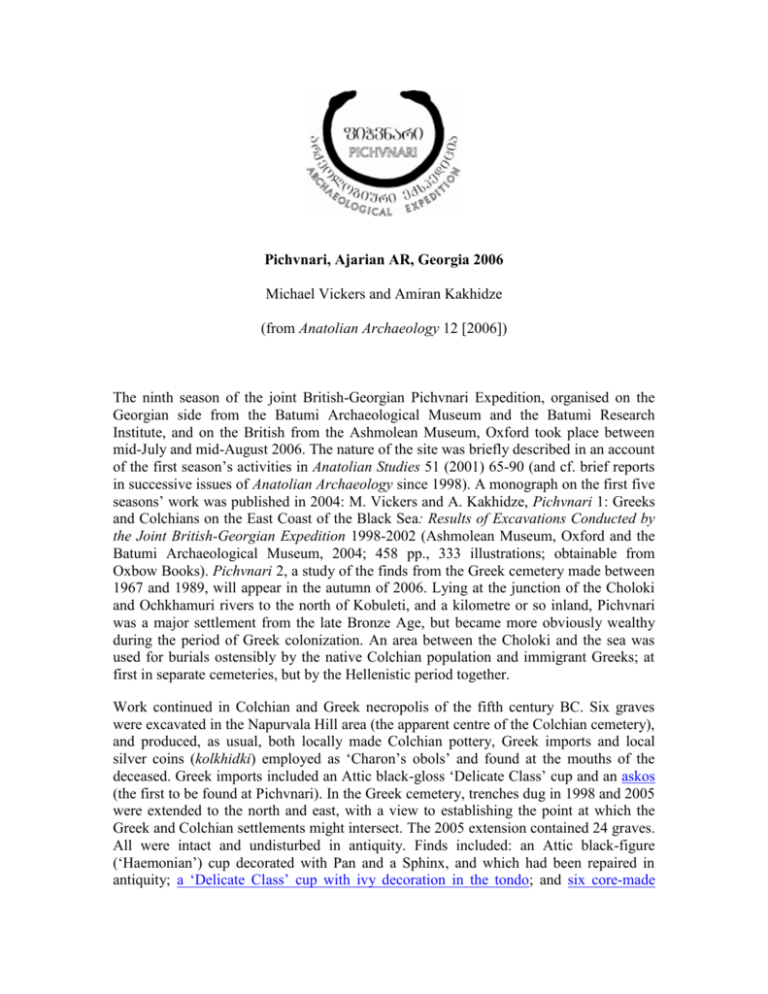
Pichvnari, Ajarian AR, Georgia 2006 Michael Vickers and Amiran Kakhidze (from Anatolian Archaeology 12 [2006]) The ninth season of the joint British-Georgian Pichvnari Expedition, organised on the Georgian side from the Batumi Archaeological Museum and the Batumi Research Institute, and on the British from the Ashmolean Museum, Oxford took place between mid-July and mid-August 2006. The nature of the site was briefly described in an account of the first season’s activities in Anatolian Studies 51 (2001) 65-90 (and cf. brief reports in successive issues of Anatolian Archaeology since 1998). A monograph on the first five seasons’ work was published in 2004: M. Vickers and A. Kakhidze, Pichvnari 1: Greeks and Colchians on the East Coast of the Black Sea: Results of Excavations Conducted by the Joint British-Georgian Expedition 1998-2002 (Ashmolean Museum, Oxford and the Batumi Archaeological Museum, 2004; 458 pp., 333 illustrations; obtainable from Oxbow Books). Pichvnari 2, a study of the finds from the Greek cemetery made between 1967 and 1989, will appear in the autumn of 2006. Lying at the junction of the Choloki and Ochkhamuri rivers to the north of Kobuleti, and a kilometre or so inland, Pichvnari was a major settlement from the late Bronze Age, but became more obviously wealthy during the period of Greek colonization. An area between the Choloki and the sea was used for burials ostensibly by the native Colchian population and immigrant Greeks; at first in separate cemeteries, but by the Hellenistic period together. Work continued in Colchian and Greek necropolis of the fifth century BC. Six graves were excavated in the Napurvala Hill area (the apparent centre of the Colchian cemetery), and produced, as usual, both locally made Colchian pottery, Greek imports and local silver coins (kolkhidki) employed as ‘Charon’s obols’ and found at the mouths of the deceased. Greek imports included an Attic black-gloss ‘Delicate Class’ cup and an askos (the first to be found at Pichvnari). In the Greek cemetery, trenches dug in 1998 and 2005 were extended to the north and east, with a view to establishing the point at which the Greek and Colchian settlements might intersect. The 2005 extension contained 24 graves. All were intact and undisturbed in antiquity. Finds included: an Attic black-figure (‘Haemonian’) cup decorated with Pan and a Sphinx, and which had been repaired in antiquity; a ‘Delicate Class’ cup with ivy decoration in the tondo; and six core-made glass vessels, an amphoriskos, a hydria and four alabastra. Three graves contained pairs of penannular silver bracelets with fawns-head finials, two of them circular, but one indented in the Achaemenid manner. There were 10 graves in the 1998 extension. One contained a Chian amphora with ‘A’ stamped on the neck. A small trench near the dig house, still in the area of the Greek cemetery, produced three graves, one of which contained a Colchian mattock (toki): a reminder that ancient Pichvnari must have had an agricultural, as well as a mercantile, aspect. It proved impossible to work in the area of the settlement this year, on account of the constant rain in the first two weeks of the season. Several soundings were made in the area of the Hellenistic cemetery, which showed that its extent was rather wider than hitherto thought: that it stretched as far as the River Choloki to the east. A structure within the area of the Hellenistic cemetery that had in the past had been taken to belong to the Bronze Age was explored by Dr Rezo Papuishvili, and proved to contain three Hellenistic graves. A partial section was dug at the 8th-7th century BC dune settlement. The co-directors of the 2006 season were again Amiran Kakhidze, Director of the Batumi Archaeological Museum and Michael Vickers, Professor of Archaeology in the University of Oxford, and Curator of Greek and Roman antiquities at the Ashmolean Museum; Dr Gia Tavamaishvili (sub-Rector of Batumi State University) was Deputy Director, and other Georgian participants included Dr Rezo Papuishvili, Dr Irakli Chevleishvili, Dr Manana Odisheli, Nino Dzneladze (archaeologists), Dr Emzar Kakhidze (historian), Anzor Javelidze (architect and surveyor), Givi Chigogidze (photographer), Zurab Varshanidze (laboratory assistant); students: Tamasi Darchidze, Vitali Kartsivadze, Sulkhan Okropiridze, Inga Iashvili (Batumi State University), Laura Graham (Jesus College, Oxford), Alfed Leprevost (Wadham College, Oxford), Lucy Minford (Magdalen College, Oxford), Henry Colburn (University of Colorado at Boulder), Alex Gorton (University of Richmond), and Emma Oxenby (University of Lund). Merabi Uzunadze worked on the digitization of illustrations for Pichvnari 2 (supported by a Major Research Grant from Jesus College, Oxford). Guliko Tsiskaradze cooked as well as ever, and Guram Svanidze ensured that we never went short of supplies. The 2006 season was supported financially by the British Institute of Archaeology at Ankara (BABSI Fund), the Oxford Craven Committee, the Oxford Marjory Wardrop Committee, the Department of Antiquities at the Ashmolean Museum, and the Batumi Archaeological Museum. Many thanks are due to all concerned. The Pichvnari website (Google ‘Pichvnari’), originally prepared by Agnieszka Frankowska of Toruń University has been updated. View for more pictures.
